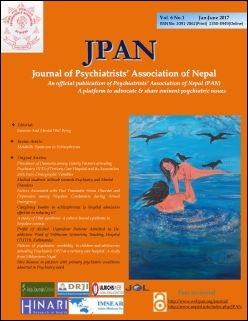Factors Associated with Post Traumatic Stress Disorder and Depression among Nepalese Combatants during Armed Insurgency
DOI:
https://doi.org/10.3126/jpan.v6i1.21768Keywords:
Post-Traumatic Stress Disorder, Combat Exposure, Nepalese ArmyAbstract
Introduction: Mental illness is major global public health problem affecting over 450 million people, most of whom live in developing countries. Nepal just overcame ten years long conflict situation. Post-traumatic stress disorder (PTSD) and depression is most prevalent in conflict inflicted areas as per most literatures. Much is not known about the psychological effects of the conflict situation, even after six years of peace process in Nepalese context.
Material and Method: This is a cross sectional descriptive study carried out to explore the prevalence of Post-traumatic stress disorder and Depression in Nepalese army combatants involved during the armed insurgency period and its relationship with different. It was conducted in two randomly selected battalions of tenth brigade in Kathmandu. The PTSD was assessed using Post traumatic stress disorder checklist - military version (PCL-M), depression was assessed using the Beck depression inventory (BDI) and degree of combat exposure was assessed using Combat exposure scale (CES). The quantitative assessment was done using appropriate methods and tools.
Results The degree of combat exposure showed 48.8% exposed to moderate and above degree of combat exposure. PTSD was found in 21.9% of the combats and 20.5% were found to have depression. Both PTSD and depression were found to be associated with degree of combat exposure. There was statistically significant association between degree of combat exposure and PTSD (p= 0.001, 95% CI (1.567-6.303)) and depression (p=0.011, 95% CI (1.209-4.830)).
Conclusion: PTSD and depression exists even six years after the peace process in Nepalese army and is related to the degree of combat exposure regardless of other attributes like age, sex, rank, marital status.
J Psychiatrists’ Association of Nepal Vol .6(1), 2017, p.24-28
Downloads
Downloads
Published
How to Cite
Issue
Section
License
This license enables reusers to distribute, remix, adapt, and build upon the material in any medium or format, so long as attribution is given to the creator. The license allows for commercial use.




